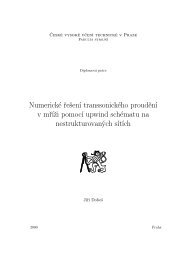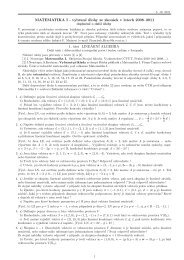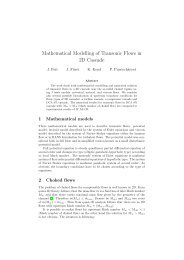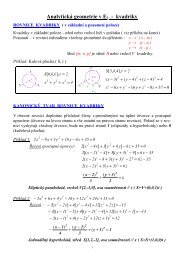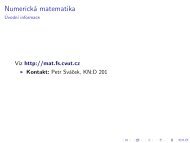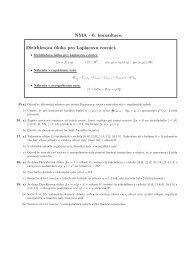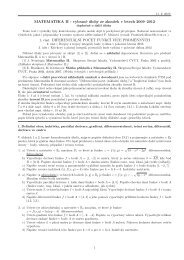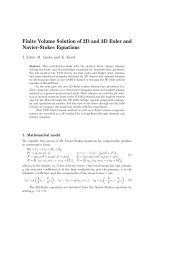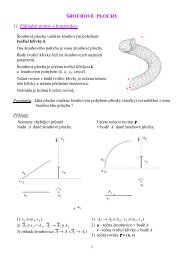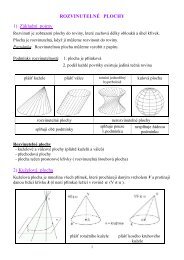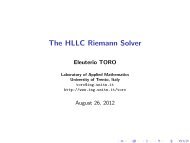MATHEMATICS II - typical problems from exam tests
MATHEMATICS II - typical problems from exam tests
MATHEMATICS II - typical problems from exam tests
You also want an ePaper? Increase the reach of your titles
YUMPU automatically turns print PDFs into web optimized ePapers that Google loves.
) Evaluate the derivative f ′ (1) and write the equation of the tangent line and the normalline to the graph of function f at the point [1, 2].c) Use the equation of the tangent line in approximate evaluation of the function value f(x)for x = 1.1 .8. a) Verify (all assumptions) that the equation F (x, y) ≡ x 2 + 2y 2 − 2xy − y = 0 implicitlydefines a function y = f(x) in a neighborhood of the point [x 0 , y 0 ] = [1, 1].b) Verify whether the function y = f(x) has a local extrem for x 0 = 1. (Give reasons foryour answer.)c) If yes, check if it is a local minimum or local maximum.9. a) Name and sketch in IE 3 surface σ described by the equationF (x, y, z) ≡ x 2 + y 2 /4 − z 2 /9 − 1 = 0.b) Write the equation of the tangent plane to surface σ at the point M = [1, −2, 3].c) Write the equation of a tangent plane to σ, parallel with the plane x + y = 0. Find thecontact point.ExtremesIn following <strong>problems</strong> investigate local extremes of function f. Calculate corresponding functionvalues.10. f(x, y) = x 3 + y 2 − 2x 2 − 2xy + 611. f(x, y) = x 2 + y 3 + 5 2 y2 − 2xy − 6y12. f(x, y) = x 3 + y 3 + 9 2 x2 − 12x − 3yIn following <strong>problems</strong>13. f(x, y) = x 2 + y − x √ y − 6x + 1214. f(x, y) = e x/2 (x + y 2 )a) Give reasons for the existence of absolute extremes of function f on given set M.b) Investigate the absolute extremes, i.e. find their position and calculate maximum andminimum values of function f on set M.15. f(x, y) = x 2 + xy − 3x − y, M = { [x, y] ∈ IE 2 ; x + y ≤ 3, x ≥ 0, y ≥ 0 }16. f(x, y) = x 2 − 2x + y 2 , M = { [x, y] ∈ IE 2 ; x 2 + y 2 ≤ 9, y ≥ 0 } (Hint: You can use polarcoordinates in the investigation of behavior of f on the upper part of the boundary.)17. f(x, y) = x 2 + y 2 − xy + x + y + 1, M = { [x, y] ∈ IE 2 ; x + y ≤ 4, x ≥ 0, y ≥ 0 }<strong>II</strong>.DOUBLE AND TRIPLE INTEGRALDouble integralIn following <strong>problems</strong>a) Sketch given set D ∈ IE 2 , including description of axes, scales, intersections of curves etc.b) Evaluate the integral ∫∫ Df(x, y) dx dy. If you apply Fubini’s theorem, verify its assumptions.c) In all <strong>problems</strong> (except 21) give at least one <strong>exam</strong>ple of a possible physical meaning of theintegral. Specify if it is a mass, static moment or moment of inertia, according to which pointor straight line, what is the density.18. a) Domain D in IE 2 is bounded by the curves x = y 2 , x − y − 2 = 0. b) f(x, y) = y 219. a) D = {[x, y] ∈ IE 2 ; x + y ≤ 1, x + 1 ≥ y ≥ 0} b) f(x, y) = x 2 + y 22
20. a) D = {[x, y] ∈ IE 2 ; 2(x + y) ≤ 5, xy ≥ 1} b) f(x, y) = 121. a) D = {[x, y] ∈ IE 2 ; x + y ≤ π, x − y ≤ π, x ≥ 0} b) f(x, y) = sin(x + y)22. a) D = {[x, y] ∈ IE 2 ; y 2 − x 2 ≤ 1, 0 ≤ x ≤ 2, y ≥ 0} b) f(x, y) = y23. a) D = {[x, y] ∈ IE 2 ; y ≥ x 2 , y ≤ −x 2 + 12} b) f(x, y) = |x|24. a) D = {[x, y] ∈ IE 2 ; x 2 + y 2 ≤ 9, y ≥ 0} b) f(x, y) = √ 9 − x 2 − y 225. a) D = {[x, y] ∈ IE 2 ; 36x 2 + y 2 ≤ 9, x ≥ 0, y ≥ 0} b) f(x, y) = xy26. a) D = {[x, y] ∈ IE 2 ; x 2 + y 2 ≤ 4x, x 2 + y 2 ≥ 2x, y ≥ 0} b) f(x, y) = xy27. Evaluate the area P of a region D ∈ IE 2 , bounded by the curves: x = y 2 , xy = 1, ( xy ≥ 1),x = 4y.In next <strong>problems</strong> calculate the mass m of a planar plate bounded by given curves (possibly alsosatisfying given inequalities).28. y = x 2 , x − y + 2 = 0, if the density ϱ(x, y) = y29. x = y 2 , xy ≥ 1, x = 4, if ϱ(x, y) = 2x30. x 2 + y 2 = 1, x + y ≥ 1, if ϱ(x, y) = y31. Find the coordinates of the center of mass T of the planar plate which is bounded by thecurves: y 2 = 4x + 4, y 2 = −2x + 4, if ϱ(x, y) = 1.32. Evaluate the moment of inertia of the set 4x 2 + y 2 ≤ 1, y ≥ 0 according to the y–axis, ifϱ(x, y) = y.Triple integral (= volume integral)In next <strong>problems</strong>a) Sketch set D ∈ IE 3 .b) Evaluate the integral ∫∫∫ Df(x, y, z) dx dy dz. If you apply Fubini’s theorem, verify its assumptions.c) In all <strong>problems</strong> give at least one <strong>exam</strong>ple of a possible physical meaning of the integral.Specify if it is a mass, static moment or moment inertia, according to which point, straightline or plane and at what density.33. a) D : x ≥ 0, y ≥ 0, x + y ≤ 1, 0 ≤ z ≤ xy b) f(x, y) = x34. a) D : 0 ≤ x ≤ 1, 0 ≤ y ≤ 1, 0 ≤ z ≤ 4 − x 2 − y 2 b) f(x, y) = x + y35. a) D : 0 ≤ z ≤ 4 − x 2 − y 2 , y ≥ 0 b) f(x, y) = x 2 y36. Evaluate the volume of the body M : x 2 + y 2 + z 2 ≤ 16, x 2 + y 2 ≤ 9. Sketch body M.37. Evaluate the volume of body M, bounded by the surfaces z = x 2 + y 2 + 4,z = 3 − x 2 − y 2 , x 2 + y 2 = 1. Sketch body M.38. Sketch body M and evaluate its mass.M = {[x, y, z] ∈ IE 3 ; √ x 2 + y 2 ≤ z ≤ 4}, the density is ρ(x, y, z) = z.39. Sketch body M and calculate its mass.M = {[x, y, z] ∈ IE 3 ; x 2 + y 2 ≤ z ≤ 4}, the density: ρ(x, y, z) = √ x 2 + y 2 .40. Calculate the mass of a ball with radius a if the density is ρ(x, y, z) = x 2 + y 2 .√41. Given an homogeneous body M = {[x, y, z] ∈ IE 3 ; x 2 + y 2 ≤ z ≤ 2}. Sketch M andevaluate its moment inertia according to the z–axis. (Use the volume integral.)42. Find the volume of the body M : 2z ≥ x 2 + y 2 , x 2 + y 2 + z 2 ≤ 3.3
<strong>II</strong>I. LINE INTEGRALS, GREEN’S THEOREM, POTENTIAL FIELDLine integral of a scalar function43. C is the first thread of the screw line x = a cos t, y = a sin t, z = at; t ∈ 〈0, 2π〉. Evaluatethe mass of line C if the longitudinal density is ϱ(x, y, z) = z 2 /(x 2 + y 2 ).44. On which of the curvesa) C . . . the circle x 2 − 2x + y 2 = 0,b) C . . . the line segment AB, where A = [2, 3], B = [0, 1]does the integral ∫y − 3x − y − 2 dsCexist? (Give reasons.) The existing integral evaluate by means of a parameterization ofcurve C.45. Evaluate the mass of the line segment <strong>from</strong> A = [1, 2] to B = [3, −5], if the longitudinaldensity is ϱ(x, y) = x 2 − y.Line integral of a vector function, Green’s theorem46. Calculate the work done by the force f ⃗ ( 2y=x 2 + 4y 2 , − 2x )x 2 + 4y 2acting on the ellipse C : x 2 /4 + y 2 = 1 counterclockwise.47. Calculate the work done by the force ⃗ f = (x cos y, 0) acting on the line segment <strong>from</strong> thepoint A = [0, 1] to the point B = [1, 2].48. Curve C is a part of the parabola y = 1 2 x2 <strong>from</strong> the point A = [0, 0] to the point B = [2, 2].Evaluate the work done by the force f ⃗ = (x + y, xy) acting on curve C.∮ ( y49. Evaluate the integralx 2 + y 2 , −x )x 2 + y 2 · ds, ⃗ where C is the left half of the circleCx 2 + y 2 = 4, oriented <strong>from</strong> the point [0, 2] to the point [0, −2].In next three <strong>problems</strong>a) write Green’s theorem,b) verify its assumptions for evaluation of a given integral,c) if the assumptions are satisfied, evaluate the integral by Green’s theorem.∮50.(− 1 )x 2 , 2x · ds, ⃗ if curve C is positively oriented and it is successively given by theCequation 1) x 2 + y 2 = 1 , 2) x 2 − 2x + y 2 = 0 , 3) (x − 2) 2 + y 2 = 1 .∮ (51. y, (x − y) 2) · ⃗ds, where C is the positively oriented circle x 2 + y 2 = 1.52.C∮Cy 2 dx + (x + y) 2 dy, if C is a positively oriented boundary of the triangle P QR, whereP = [4, 0], Q = [4, 4], R = [0, 4].∮53. a) Evaluate the integralC is negatively oriented.C( yx 2 + y 2 + y,−x )x 2 + y 2 · ds, ⃗ where C = {[x, y]; x 2 + y 2 = 4},b) Can the integral be evaluated by Green’s theorem? (Give reasons for your answer.)4
Independence of the line integral of a vector function of the path, Potential field54. a) Explain what it means that the integral ∫ ⃗ Cf · ⃗ds does not depend on the path in domainΩ ⊂ E 2 .∫b) Does the integralC (y sin x , y − cos x) · ⃗ds depend on the path in E 2 ? (Give reasons.)c) If the vector field (y sin x , y − cos x) is a potential field in IE 2 , find the potential.55. a) Verify if the function ϕ(x, y, z) = 1 2 ln(x2 + y 2 ) + z 2 is a potential of the vector field⃗f(x, y, z) =( xx 2 + y 2 ,y )x 2 + y 2 , 2zin the domain G = {[x, y, z] ∈ E 3 ; x 2 + y 2 > 0}.∫b) Evaluate the line integral ⃗ Cf · ⃗ds, where C is the curve in G with the initial point[1, 0, 0] and the end point [0, 1, 1].56. The function ψ = xy + xz + yz is a potential of the vector field ⃗ f.a) In which maximum domain D in E 3 has ψ continuous partial derivatives? Express vectorfield ⃗ f in domain D.b) Does the vector field ⃗ f, except for ψ, have another potential in D? Give the form of sucha potential.c) Evaluate ∫ C ⃗ f · ⃗ds where curve C is given by parametric equationsx = −1 + t, y = 2 + t/2, z = − cos(tπ/4) for t ∈ 〈0, 4〉.57. ⃗ f =( −yx 2 + y 2 ,x )x 2 + y 2a) Curve C is the positively oriented circle x 2 + y 2 = 4. Evaluate the line integral of ⃗ f onC by means of parameterization of C.b) Is the vector field ⃗ f potential in the domain D = {[x, y] ∈ IE 2 ; x 2 + y 2 > 0}? (Givereasons.)In next five <strong>problems</strong>a) write sufficient conditions which guarantee that the vector field ⃗ f = (u, v) (respectively⃗f = (u, v, w)) is a potential field in domain D ⊂ IE 2 (respectively D ⊂ IE 3 ),b) verify if the conditions are satisfied for given vector field ⃗ f and given domain D,c) if the conditions are satisfied, find the potential and use it in the evaluation of the line integralof ⃗ f on given line C.58. f ⃗ = [cos(2y) + y + x] ⃗i + [y − 2x sin(2y) + x]⃗j, D = E 2 , C is the curve with the initialpoint A = [0, 7] and the end point B = [1, 0]59. ⃗ f =( xx 2 + y 2 ,y )x 2 + y 2 , D = { [x, y] ∈ IE 2 ; x > 0, y > 0 },C is the positively oriented circle (x − 1) 2 + (y − 1) 2 = 1 460. ⃗ f = (x + y, x − y), D = IE2 , C is the curve with the initial point A = [0, 2] and the endpoint B = [−2, 4]61. ⃗ f = (y sin x, y − cos x), D = E2 , C is the curve with the initial point A = [0, 0] and theend point B = [0, π]62. ⃗ f = (y + z, x + z, x + y), D = IE3 , C is the curve with the initial point A = [0, 0, 1] andthe end point B = [1, 1, 0]5
IV. SURFACE INTEGRALS, GAUSS–OSTROGRADSKIJ THEOREMArea, Surface integral of a scalar functionIn next three <strong>problems</strong>a) sketch surface Q ⊂ E 3 and suggest its parameterization,b) evaluate the area of Q.63. Q : z = x 2 + y 2 , x 2 + y 2 ≤ 1,64. Q : 3x + 4y + z = 1, x ≥ 0, y ≥ 0, z ≥ 065. Q : z = √ 12 − x 2 − y 2 , x 2 + y 2 ≤ 866. Evaluate the moment of inertia of the homogeneous surfaceQ : z = √ x 2 + y 2 , z ≤ 1 according to the z–axis.Flux of a vector field through the surface, Surface integral of a vector functionIn next five <strong>problems</strong>a) Sketch surface Q and suggest its parameterization.b) Evaluate the flux of the vector field ⃗ f through surface Q (oriented by the normal vector ⃗n).67. ⃗ f = (y, x, 0), Q = {[x, y, z] ∈ IE3 ; z = 4 − x 2 − y 2 , x ≥ 0, y ≥ 0, z ≥ 0}, the anglebetween the vectors ⃗n and ⃗ k = (0, 0, 1) is acute.68. ⃗ f = (z, y, 2x), Q = {[x, y, z] ∈ IE3 ; x + 2y + z = 6, x ≥ 0, y ≥ 0, z ≥ 0}, the anglebetween the vectors ⃗n and ⃗ k = (0, 0, 1) is acute.69. ⃗ f = (y, x, z), Q = {[x, y, z] ∈ IE3 ; x 2 + y 2 = 16, 0 ≤ z ≤ 3, x ≥ 0, y ≥ 0}, ⃗n(4, 0, 0) =⃗i.70. ⃗ f = (x, y, 0), Q : z = 9 − x 2 − y 2 , z ≥ 0, the component n 3 of ⃗n = (n 1 , n 2 , n 3 ) is positive.71. ⃗ f = (z, x 2 + y 2 , 1), Q : z = √ x 2 + y 2 , 0 ≤ z ≤ 2, ⃗n · ⃗k < 0.Gauss–Ostrogradski theoremIn next <strong>problems</strong>a) Write the Gauss–Ostrogradskij theorem.b) Verify its assumptions for a given vector field ⃗ f and given surface Q.c) Evaluate the flux of ⃗ f through Q.72. ⃗ f = (y, x, z 2 ), Q is the surface of the body M = { [x, y, z] ∈ IE 3 ; x 2 + y 2 + z 2 ≤ 4, z ≥ 0}.Surface Q is oriented to the exterior of M.73. ⃗ f = (x 3 , y 3 , z 3 ), Q = Q 1 ∪Q 2 , where Q 1 : x 2 +y 2 +z 2 = 1, z ≤ 0, Q 2 : z = 0, x 2 +y 2 ≤ 1,surface Q is oriented to the interior.74. ⃗ f = (x 2 , y 2 , z 2 ), Q is the surface of the cube 0 ≤ x ≤ a, 0 ≤ y ≤ a, 0 ≤ z ≤ a,oriented to the exterior.75. ⃗ f = (2x + y 2 , 0, 2x − y 2 ), Q is the surface of the cone x 2 + y 2 = z 2 , 0 ≤ z ≤ 9,oriented to the exterior.76. ⃗ f = (x 3 , z, y), Q is the surface of the body z ≥ x 2 + y 2 , z ≤ 4,oriented to the exterior.6



